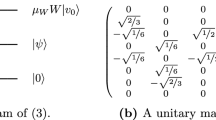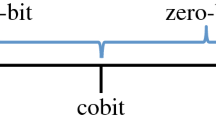Abstract
Quantum communication channels suffer from various noises, which are mathematically modeled by error super-operators. To combat these errors, it is necessary to design recovery super-operators. We aim to construct the optimal recovery that maximizes the minimum fidelity through the noisy channel. It is typically a MAX–MIN problem, out of the scope of convex optimization. Compared to existing methods, our method is exact and complete by a reduction to quantifier elimination over real closed fields in a fragment of two alternative quantifier blocks. Finally, the complexity is shown to be in EXP.

Similar content being viewed by others
Notes
It refers to polynomial with rational coefficients. As all entries in the input \(\mathscr {E}\) are supposed to be rational, we would simply write ‘polynomial’ for ‘\(\mathbb {Q}\)-polynomial,’ unless it is specified otherwise.
We prefer to encode the square of the fidelity here, rather than the fidelity, since the latter is generally expressed as a square root of an SOS polynomial. The order between fidelities could be correspondingly replaced with the order between their squares.
Encoding complex entries amounts to encoding their real and imaginary parts, which are clearly real. So it is generic to tackle real algebraic numbers \(\Omega \) only.
References
Abu-Nada, A., Fortescue, B., Byrd, M.: Optimizing the frequency of quantum error correction. Phys. Rev Lett. 119(19):article no. 190502 (2017)
Basu, S., Pollack, R., Roy, M.F.: Algorithms in Real Algebraic Geometry, 2nd edn. Springer, Berlin (2006)
Bennett, C.H., Brassard, G.: Quantum cryptography: Public key distribution and coin tossing. In: Proceedings of IEEE International Conference on Computers, Systems and Signal Processing, pp. 175–179 (1984)
Blondel, V.D., Jeandel, E., Koiran, P., Portier, N.: Decidable and undecidable problems about quantum automata. SIAM J. Comput. 34(6), 1464–1473 (2005)
Calderbank, A.R., Shor, P.W.: Good quantum error-correcting codes exist. Phys. Rev. A 54(2), 1098–1105 (1996)
Devitt, S.J., Munro, W.J., Nemoto, K.: Quantum error correction for beginners. Rep. Prog. Phys. 76(7):article no. 076001 (2013)
Dolzmann, A., Sturm, T.: REDLOG: computer algebra meets computer logic. ACM SIGSAM Bull 31(2), 2–9 (1997)
Fletcher, A.S., Shor, P.W., Win, M.Z.: Optimum quantum error recovery using semidefinite programming. Phys. Rev. A 75(1):article no. 012338 (2007)
Fletcher, A.S., Shor, P.W., Win, M.Z.: Structured near-optimal channel-adapted quantum error correction. Phys. Rev. A 77(1):article no. 012320 (2008)
Gottesman, D.: Stabilizer codes and quantum error correction. PhD dissertation, California Institute of Technology (1997)
Kiktenko, E.O., Trushechkin, A.S., Lim, C.C.W., Kurochkin, Y.V., Fedorov, A.K.: Symmetric blind information reconciliation for quantum key distribution. Phys. Rev. Appl. 8(4):article no. 044017 (2017)
Knill, E., Laflamme, R.: Theory of quantum error-correcting codes. Phys. Rev. A 55(2), 900–911 (1997)
Kosut, R.L., Shabani, A., Lidar, D.A.: Quantum error correction via convex optimization. Phys. Rev. Lett. 100(2):article no. 020502 (2008)
Long, G.L., Liu, X.S.: Theoretically efficient high-capacity quantum-key-distribution scheme. Phys. Rev. A 65(3):article no. 032302 (2002)
MacWilliams, F.J., Sloane, N.J.A.: The Theory of Error-Correcting Codes. North Holland Publishing Co, Amsterdam (1977)
Mandayam, P., Ng, H.K.: Towards a unified framework for approximate quantum error correction. Phys. Rev. A 86(1):article no. 012335 (2012)
de Moura, L., Bjørner, N.: Z3: an efficient SMT solver. In: Proceedings of 14th International Conference on Tools and Algorithms for the Construction and Analysis of Systems (TACAS). Springer, pp. 337–340 (2008)
Mousolou, V.A.: Entanglement fidelity and measure of entanglement. Quantum Inf. Process. 19:article no. 329 (2020)
Nielsen, M.A., Chuang, I.L.: Quantum Computation and Quantum Information. Cambridge University Press, Cambridge (2000)
Niu, P.H., Wu, J.W., Yin, L.G., Long, G.L.: Security analysis of measurement-device-independent quantum secure direct communication. Quantum Inf. Process. 19(10), 1–14 (2020)
Post, E.L.: A variant of a recursively unsolvable problem. Bull. Am. Math. Soc. 52(6), 264–268 (1946)
Qi, R., Sun, Z., Lin, Z., Niu, P., Hao, W., Song, L., Huang, Q., Gao, J., Yin, L., Long, G.L.: Implementation and security analysis of practical quantum secure direct communication. Light Sci. Appl. 8(1):article no. 22 (2019)
Rastegin, A.E.: Partitioned trace distances. Quantum Inf. Process. 9(1), 61–73 (2009)
Reimpell, M., Werner, R.F.: Iterative optimization of quantum error correcting codes. Phys. Rev. Lett. 94(8):article no. 080501 (2005)
Shor, P.W.: Scheme for reducing decoherence in quantum computer memory. Phys. Rev. A 52(4), R2493–R2496 (1995)
Shor, P.W., Preskill, J.: Simple proof of security of the BB84 quantum key distribution protocol. Phys. Rev. Lett. 85(2), 441–444 (2000)
Steane, A.M.: Error correcting codes in quantum theory. Phys. Rev. Lett. 77(5), 793–797 (1996)
Tarski, A.: A Decision Method for Elementary Algebra and Geometry, 2nd edn. University of California Press, Berkeley (1951)
Thinh, L.P., Faist, P., Helsen, J., Elkouss, D., Wehner, S.: Practical and reliable error bars for quantum process tomography. Phys. Rev. A 99(5):article no. 052311 (2019)
Uhlmann, A.: On “partial” fidelities. Rep. Math. Phys. 45(3), 407–418 (2000)
Wen, K., Long, G.L.: One-party quantum-error-correcting codes for unbalanced errors: principles and application to quantum dense coding and quantum secure direct communication. Int. J. Quantum Inf. 8(04), 697–719 (2010)
Wolf, M.M., Cubitt, T.S., Pérez-García, D.: Are problems in quantum information theory (un)decidable? CoRR abs/1111.5425. arxiv:1111.5425 (2011)
Wootters, W.K., Zurek, W.H.: A single quantum cannot be cloned. Nature 299, 802–803 (1982)
Wu, J., Lin, Z., Yin, L., Long, G.: Security of quantum secure direct communication based on Wyner’s wiretap channel theory. Quantum Eng. 1(4):article no. 26 (2019)
Yamamoto, N.: Exact solution for the max–min quantum error recovery problem. In: Proceedings of 48th IEEE Conference on Decision and Control (CDC). IEEE, pp. 1433–1438 (2009)
Yamamoto, N., Hara, S., Tsumura, K.: Suboptimal quantum-error-correcting procedure based on semidefinite programming. Phys. Rev. A 71(2):article no. 022322 (2005)
Acknowledgements
The authors thank the anonymous reviewers whose insightful comments resolve inconsistencies. The authors are also grateful to Yuan Feng for his valuable suggestions and Jianling Fu for her careful proof-reading. M. Xu is supported by the National Natural Science Foundation of China (No. 11871221), the National Key R&D Program of China (No. 2018YFA0306704) and the Research Funds of Happiness Flower ECNU (No. 2020ECNU-XFZH005). Y. Deng is supported by the National Natural Science Foundation of China (Nos. 61832015, 62072176) and the Inria-CAS joint project Quasar.
Author information
Authors and Affiliations
Corresponding author
Additional information
Publisher's Note
Springer Nature remains neutral with regard to jurisdictional claims in published maps and institutional affiliations.
Rights and permissions
About this article
Cite this article
Sun, YJ., Xu, M. & Deng, Y. An optimal quantum error-correcting procedure using quantifier elimination. Quantum Inf Process 20, 170 (2021). https://doi.org/10.1007/s11128-021-03109-w
Received:
Accepted:
Published:
DOI: https://doi.org/10.1007/s11128-021-03109-w




